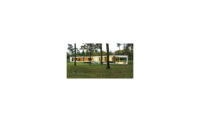Kamperland, Holland
In a gravity-defying act of daredevil modernism, a villa in the Dutch province of Zeeland seemingly floats above the surroundings it was named after—the former 60-acre Kogelhof farm. In its uncompromising radicalism, this clear, linear house would stand out anywhere, but, among the brick houses and tarred barns dotting this rural part of the Netherlands, it is truly an anomaly.
The project's agenda was as ambitious as the concept is simple. Zwijnenburg wanted the house to be a clean, transparent abstract form with no distracting elements, such as windows, on the skin. The architect, Paul de Ruiter, was intent on making the glass box energy neutral. They both managed to get their way in a feat of engineering that, says de Ruiter, “took an hour to think up and six years to execute.”
During three of those years, Zwijnenburg lived in a tiny camper next to the building site on weekdays. For bathing, he used a new Z-shaped pond the project's landscape architect Bosch & Slabbers created by excavating 2,472,000 cubic feet of soil. The firm devised the 1,312-foot-long-by-98-foot-wide man-made lake as an inviting habitat for birds and fish, reusing the dug-up earth to vary the flat site with gentle hills. They also planted 71,000 young trees.
The 7,700-square-foot house consists of two perpendicular volumes connected by a concrete core with a glazed entrance at grade. One is tucked beneath a 2-foot-deep reflecting pool and houses an office, storage, full bath, and a garage for Zwijnenburg's tractor and four cars. The small water feature, positioned to overlook the larger Z-shaped pond, was added to enhance views from the house as well as to conceal the home's plumbing, electrical, and HVAC. The upper volume, a glazed Vierendeel truss structure, hovers above the ground and accommodates the primary living, dining, and sleeping spaces. The improbable cantilever created by the structural arrangement is buttressed by a V-shaped steel support located 82 feet from the core.
De Ruiter applied a similar sweeping approach to the interior of this home for a family of four that includes two teenagers, and it is every bit as cool and collected (that is, maniacally tidy) inside as it is outside. By his own admission, Zwijnenburg is neurotic about cleaning up and organizing. “Even my cars are organized by size and color,” he says. Interestingly, he selected de Ruiter for the project on the basis of an underground parking garage the architect had designed in Rotterdam. “I've always been fascinated by functional, minimalist architecture, especially in America,” Zwijnenburg says. “I like big open spaces with no clutter.”
The rooms upstairs are delineated according to the structural bays. The master bedroom is at one end, followed by its bath suite and an internal open-air patio, accessible from both the master bath and living room beyond—a scheme that maintains an uninterrupted curtain wall. The kitchen, dining area, and children's rooms align to complete the floor plan. Modern classics by the likes of Eileen Gray and Le Corbusier constitute the home's sparse furnishings.
The aesthetic does not compromise the architect's goal to build a net zero–ready house, however. To that end de Ruiter is employing both active and passive means. The facade is made of dual-glazed low-iron, low-E glass insulated with Argon gas. The 11-foot-tall glass panels, fastened with U-shaped clips to a steel frame on the building's exterior, slip past the 9-foot-high curtain-wall opening and seem to disappear beyond the floor and ceiling edges, erasing the line between indoors and out, like an infinity pool. Sunshades, seven inches behind the glazing, provide an additional air barrier, aided by a dedicated ventilation system that draws solar heat buildup outside. Meanwhile, a heat pump maintains comfortable temperatures throughout the year, and will get a boost during winter months from a soon-to-be-installed freestanding stove fueled by wood pellets—to be produced from the trees on the property (when they mature).
A work in progress, Villa Kogelhof is not yet producing as much energy as it consumes. Photovoltaic panels on the roof currently meet some of its demands. But the house won't be fully net zero until these are supplemented by the installation of a wind turbine, planned for the near future.
Such apparent independence can be deceiving. Surrounded by a surreal landscape that is at once wild and calculated, private and public, Zwijnenburg muses that there are times at the Villa Kogelhof when, “One is able to cherish the illusion that you are the only person in the world.”
PeopleClient: withheld Owner: withheld
Architect:
Personnel in architect's firm who should receive special credit: Interior designer: Paul de Ruiter Architects (Amsterdam)
Engineers:
Building physics: Costs: Studio Bouwhaven (Barendrecht)
Installations: Glass: Si-X (Benthuizen) Steel structure: Meijers Staalbouw (Serooskerke)
Consultant(s): Lighting: InventDesign (Amsterdam) General contractor: Bouwbedrijf J. van de Linde (Goes)
Photographer(s): Size: 7,700 square feet Cost: $3.5 million Completion date: January 2013 |
Products
Structural system Manufacturer of any structural components unique to this project: Meijers Staalbouw (Serooskerke)
Exterior cladding Metal/glass curtain wall: TG-THERM®sun SKN165 Fassades, Thiele Glass,SI-X Precast concrete: Walls Parking garage, Covers sides pond, Staircase Curtain wall: TG-THERM®sun SKN165 Fassades, Thiele Glass, SI-X
Roofing Elastomeric: EPDM Metal: Steel frames, Meijers Staalbouw Other: Glass panels around staircase, TG-THERM®sun SKN165 with coating on the inside layer
Windows
Glazing Skylights: TG-THERM®sun SKN165 4.2m x 2.4m
Doors Main entrance Steel support frame behind TG-THERM®sun SKN165 glass Sliding doors: Glass TG-PROTECT®
Interior finishes Paneling: Breedveld sliding panel door, between bedrooms Raised flooring: Senso flooring, Fusion®, white
Furnishings
Tables:
Lighting Downlights: Dose, Modular Task lighting: BES Hanging, BES standing by Ferrolight, Hendrik Ido Ambacht Dimming System or other lighting controls: GIRA E2, KNX control system
Plumbing
Energy Other unique products that contribute to sustainability: Climate facade of sun screen on inside of the glass facade, Sunscreens by Vitrona, Waalwijk Add any additional building components or special equipment that made a significant contribution to this project: A windmill (!)is planned to be build on the Kogelhof estate |














Post a comment to this article
Report Abusive Comment